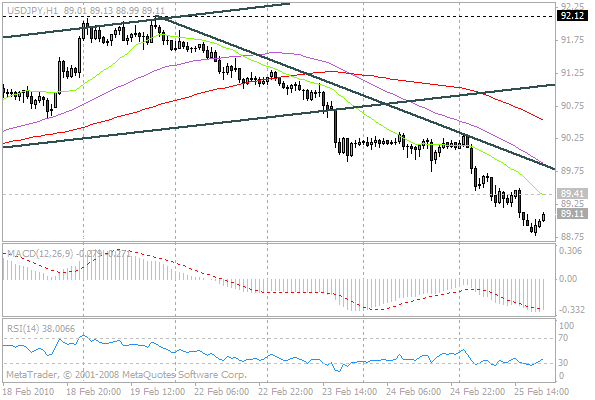Source: ForexYard
The U.S. Unemployment Claims is the primary publication today that is set to determine the level of the USD when it is released at 13:30 GMT. The other main releases that are set to dominate forex trading, especially for currencies such as the Dollar and EUR is the publication of the German Unemployment Change and British CBI Sales at 8:55 GMT and 12:45 GMT respectively. Traders may find good opportunities to enter the market following these vital announcements.
Economic News
USD – New Home Sales Fall Sharply
The dollar fell against the Yen and EUR Wednesday after data showed sales of new U.S. homes fell sharply in January, raising doubts about the U.S. economy and causing investors to reduce exposure to risk. Sales of newly built U.S. single-family homes unexpectedly fell to a record low in January, dropping 11.2 %. As a result, the EUR/USD shot up over 30 pips before correcting itself. Currently the pair is trading around the 1.3490 level. Similarly, the USD/JPY pair fell almost 80 pips, pushing the oft-traded currency pair to 89.60.
The greenback also remained under selling pressure on expectations that U.S. interest rates will stay at very low levels for some time, following comments by Federal Reserve chief Bernanke on Wednesday. Low interest rates make the dollar less attractive to investors than higher-yielding currencies, stocks and commodities. In addition, the economic recovery does not appear to be improving at the speed many investors were hoping for, and currencies appear to be tracing the movement of stocks as a result.
Looking ahead to today, the most important economic indicators scheduled to be released from the U.S. are the Unemployment Claims and Durable Goods Orders at 13:30 GMT. Traders will be paying close attention to today’s announcement as a stronger than expected result may boost the USD in the short-term. Traders are also advised to follow Federal Reserve Chairman Ben Bernanke’s testimony at around 14:00 GMT. This testimony is very important as it is very likely to impact the Dollar’s volatility. Traders are advised to watch closely, as this is likely to set the pace of the dollar going into the rest of the week’s trading
EUR – German Unemployment Change on Tap
The EUR completed yesterday’s trading session with mixed results versus the major currencies. The 16 nation currency was little changed against the USD and the pair closed at 1.3490 levels, but slightly higher against the GBP in a volatile session and closed at 0.8785 levels.
The EUR fell to a nine-month low of $1.3440 last week on concerns about Greece’s public finances. A rating downgrade of Greece’s four largest banks by Fitch on Tuesday reminded investors of the financial woes facing the country. Moreover, recent data showing German consumer sentiment set to decline in March also added to negative EUR sentiment, as did a weak German business sentiment Tuesday.
Sterling pound rose 0.2% to $1.5430 against the USD in the early trading yesterday, after having tumbled on Tuesday when the Bank of England left the door open to more emergency measures and issued a downbeat economic outlook.
Looking ahead today, the news event that may have a very large impact on the EUR and its main currency pairs in today’s trading is the German Unemployment Change around 8.55 GMT. This report is very important and is likely to impact the EUR’s volatility. Traders should pay close attention to the market as there is an opportunity for traders to capitalize on the fluctuations which are likely to follow this release
JPY – Yen Gains against Most Major Currency Counterparts
The Yen experienced a bullish trading session yesterday, as it appreciated against most of its major currency pairs. The JPY extended gains versus the EUR during yesterday trading session and closed at 120.90. The Japanese yen also saw bullishness against the USD as it jumped around 80 pips and closed at 89.60.
The JPY’s trends will be affected by the rallies of its primary currency pairs today. It seems that the USD and EUR are expected to continue a volatile trading session today, especially against the Japanese currency. Traders should keep a close look on the news coming from the U.S. and Europe as these economies will be the deciding factors in the JPY’s movement today, especially the U.S Unemployment Claims at 13:30 GMT. It is also advisable for traders to follow any unexpected comments coming from key Japanese governmental figures, as this is also likely to lead to further JPY volatility.
OIL – Oil Recovers, Climbing Above $80 a Barrel
Crude oil rose more than $1 to $80.20 a barrel after Federal Reserve Chairman Bernanke said the U.S. economy is in a “nascent” recovery that requires low interest rates to encourage demand by consumers and businesses.
Oil climbed 1.5% as Bernanke told the House Financial Services Committee that private-sector demand growth for goods and services will fuel the rebound. The Energy Department reported oil supplies gained 3.03 million barrels last week to 337.5 million, the highest level since November.
As for today, traders are advised to watch carefully the leading stock markets and the major economic indicators which will be published from the U.S. and Euro-Zone in order to predict the next movement in oil prices.
Technical News
EUR/USD
The latest downtrend in this pair has pushed the price into the over-sold territory on the RSI of the hourly and 4-hour charts, indicating that a downward correction may be imminent. With fresh bullish crosses occurring on the hourly charts Slow Stochastic, this notion may indeed be correct. Going long might be a wise choice today
GBP/USD
The pair is continuing its bearish development, as the cable dropped almost 300 pips in the past 2 days. All oscillators on the hourly chart are pointing down, indicating that the falling trend has more room to go. Next price target might be 1.5250.
USD/JPY
The Slow Stochastic and the RSI on the 4H chart are showing a continuation of the current bearish correction. There is also a very accurate bearish channel forming on the daily chart. In addition, all indicators on the hourly chart are pointing down. Going short might be the right choice today
USD/CHF
The bullish momentum continues with full steam as the pair breached the key Fibonacci level of 1.0850. Currently, all oscillators on the daily chart are giving bullish signals; hence, going long seems to be preferable
The Wild Card
CHF/JPY
The latest downward movement on this pair has given traders two distinct signals for a bullish correction later today. The first is a bullish cross on the 1 hour Slow Stochastic, suggesting a upward movement is imminent. The second is a fresh doji candlestick formation on the 4-hour chart, which typically signals a reversal is in the making. Entering long positions as soon as possible may help forex traders capture decent profits.
Forex Market Analysis provided by Forex Yard.
© 2006 by FxYard Ltd
Disclaimer: Trading Foreign Exchange carries a high level of risk and may not be suitable for all investors. There is a possibility that you could sustain a loss of all of your investment and therefore you should not invest money that you cannot afford to lose. You should be aware of all the risks associated with Foreign Exchange trading.








